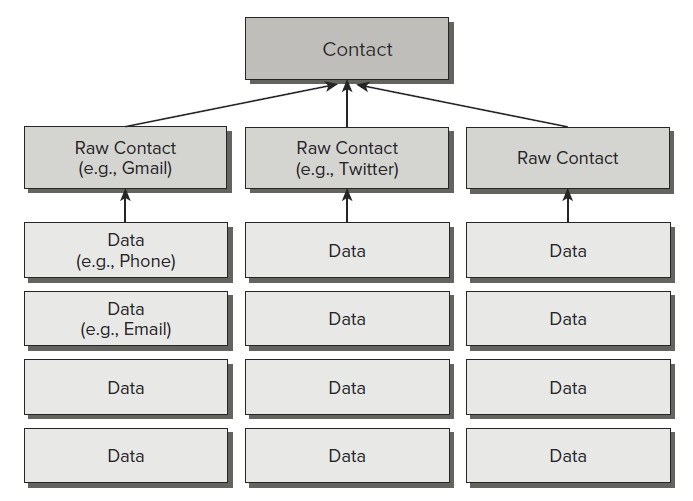Android 4 学习(18):搜索
参考《Professional Android 4 Development》
搜索
通过下面这几种方式可以给应用程序添加搜索功能:
- Search Bar

- Search View

- Quick Search Box

可搜索的Content Provider
首先,要在res./xml目录下创建一个xml文件,例如:
<?xml version=”1.0” encoding=”utf-8”?>
<searchable xmlns:android=”http://schemas.android.com/apk/res/android” android:label=”@string/app_name” android:hint=”@string/search_hint”>
</searchable>
其中,Label一般是应用程序的名称。
为应用程序创建Search Activity
Search Activity和普通的Activity不同,它是一直在back stack的栈顶,每次有新的search activity创建时,不会有将其简单的入栈,因为用户是不会希望按返回键时返回自己前面的查询结果。为了表明该Activity可以被搜索,需要将android.intent.action.SEARCH加入到自己的Intent Filter中,同时需要将前面创建的searchable的xml文件加到meta-data标签中:
<activity android:name=”.DatabaseSkeletonSearchActivity” android:label=”Element Search” android:launchMode=”singleTop”>
<intent-filter>
<action android:name=”android.intent.action.SEARCH” />
<category android:name=”android.intent.category.DEFAULT” />
</intent-filter>
<meta-data android:name=”android.app.searchable” android:resource=”@xml/searchable” />
</activity>
用户进行搜索后,可以在搜索结果中继续搜索,而这种操作会生成新的Intent,而这些Intent可以通过onNewIntent handler来处理:
@Override
public void onCreate(Bundle savedInstanceState) {
super.onCreate(savedInstanceState);
// Get the launch Intent
parseIntent(getIntent());
}
@Override
protected void onNewIntent(Intent intent) {
super.onNewIntent(intent);
parseIntent(getIntent());
}
private void parseIntent(Intent intent) {
// If the Activity was started to service a Search request, extract the search query.
if (Intent.ACTION_SEARCH.equals(intent.getAction())) {
String searchQuery = intent.getStringExtra(SearchManager.QUERY);
// Perform the search
performSearch(searchQuery);
}
}
设置默认的Serach Provider
在应用程序中,最好设置一个Activity,让所有的搜索结果都从这个Activity中出来,设置方法也简单,将下面的配置加到程序配置中就可以了:
<meta-data android:name=”android.app.default_searchable” android:value=”.DatabaseSkeletonSearchActivity” />
使用Cursor Loader的Search Activity示例
import android.app.ListActivity;
import android.app.LoaderManager;
import android.app.SearchManager;
import android.content.ContentUris;
import android.content.CursorLoader;
import android.content.Intent;
import android.content.Loader;
import android.database.Cursor;
import android.net.Uri;
import android.os.Bundle;
import android.view.View;
import android.widget.ListView;
import android.widget.SimpleCursorAdapter;
public class DatabaseSkeletonSearchActivity extends ListActivity implements LoaderManager.LoaderCallbacks<Cursor> {
private static String QUERY_EXTRA_KEY = “QUERY_EXTRA_KEY”;
private SimpleCursorAdapter adapter;
@Override
public void onCreate(Bundle savedInstanceState) {
super.onCreate(savedInstanceState);
// Create a new adapter and bind it to the List View
adapter = new SimpleCursorAdapter(this, android.R.layout.simple_list_item_1, null, new String[] { MyContentProvider.KEY_COLUMN_1_NAME }, new int[] { android.R.id.text1 }, 0);
setListAdapter(adapter);
// Initiate the Cursor Loader
getLoaderManager().initLoader(0, null, this);
// Get the launch Intent
parseIntent(getIntent());
}
@Override
protected void onNewIntent(Intent intent) {
super.onNewIntent(intent);
parseIntent(getIntent());
}
private void parseIntent(Intent intent) {
// If the Activity was started to service a Search request, extract the search query.
if (Intent.ACTION_SEARCH.equals(intent.getAction())) {
String searchQuery = intent.getStringExtra(SearchManager.QUERY);
// Perform the search
performSearch(searchQuery);
}
}
// Execute the search.
private void performSearch(String query) {
// Pass the search query as an argument to the Cursor Loader
Bundle args = new Bundle();
args.putString(QUERY_EXTRA_KEY, query);
// Restart the Cursor Loader to execute the new query.
getLoaderManager().restartLoader(0, args, this);
}
public Loader<Cursor> onCreateLoader(int id, Bundle args) {
String query = “0”;
// Extract the search query from the arguments.
if (args != null)
query = args.getString(QUERY_EXTRA_KEY);
// Construct the new query in the form of a Cursor Loader.
String[] projection = {MyContentProvider.KEY_ID, MyContentProvider.KEY_COLUMN_1_NAME};
String where = MyContentProvider.KEY_COLUMN_1_NAME + “ LIKE \”%” + query + “%\””;
String[] whereArgs = null;
String sortOrder = MyContentProvider.KEY_COLUMN_1_NAME + “ COLLATE LOCALIZED ASC”;
// Create the new Cursor loader.
return new CursorLoader(this, MyContentProvider.CONTENT_URI, projection, where, whereArgs, sortOrder);
}
public void onLoadFinished(Loader<Cursor> loader, Cursor cursor) {
// Replace the result Cursor displayed by the Cursor Adapter with the new result set.
adapter.swapCursor(cursor);
}
public void onLoaderReset(Loader<Cursor> loader) {
// Remove the existing result Cursor from the List Adapter.
adapter.swapCursor(null);
}
}
大部分情况下,我们需要响应对搜索结果的click事件,因此需要重写onListItemClick方法:
@Override
protected void onListItemClick(ListView listView, View view, int position, long id) {
super.onListItemClick(listView, view, position, id);
// Create a URI to the selected item.
Uri selectedUri = ContentUris.withAppendedId(MyContentProvider.CONTENT_URI, id);
// Create an Intent to view the selected item.
Intent intent = new Intent(Intent.ACTION_VIEW);
intent.setData(selectedUri);
// Start an Activity to view the selected item.
startActivity(intent);
}
使用Search View Widget
Android 3.0后推出了Search View Widget以替代Search Activity。将Search View绑定到searchable activity中,首先要获取searchableInfo:
// Use the Search Manager to find the SearchableInfo related to this Activity.
SearchManager searchManager = (SearchManager)getSystemService(Context.SEARCH_SERVICE);
SearchableInfo searchableInfo = searchManager.getSearchableInfo(getComponentName());
// Bind the Activity’s SearchableInfo to the Search View
SearchView searchView = (SearchView)findViewById(R.id.searchView);
searchView.setSearchableInfo(searchableInfo);
本地Android Content Provider
Android中提供了一些本地的Content Provider,包括下面这些:
- Media Store
- Browser
- Contacts Contract
- Calendar
- Call Log
使用Media Store Content Provider
MediaStore类有Audio,Video和Image子类,这些子类又有含有uri信息的子类。每个子类中uri信息是这么存储的:
- MediaStore.<mediatype>.Media.EXTERNAL_CONTENT_URI
- MediaStore.<mediatype>.Media.INTERNAL_CONTENT_URI
下面是一个示例:
// Get a Cursor over every piece of audio on the external volume,
// extracting the song title and album name.
String[] projection = new String[] {
MediaStore.Audio.AudioColumns.ALBUM,
MediaStore.Audio.AudioColumns.TITLE
};
Uri contentUri = MediaStore.Audio.Media.EXTERNAL_CONTENT_URI;
Cursor cursor = getContentResolver().query(contentUri, projection, null, null, null);
// Get the index of the columns we need.
int albumIdx = cursor.getColumnIndexOrThrow(MediaStore.Audio.AudioColumns.ALBUM);
int titleIdx = cursor.getColumnIndexOrThrow(MediaStore.Audio.AudioColumns.TITLE);
// Create an array to store the result set.
String[] result = new String[cursor.getCount()];
// Iterate over the Cursor, extracting each album name and song title.
while (cursor.moveToNext()) {
// Extract the song title.
String title = cursor.getString(titleIdx);
// Extract the album name.
String album = cursor.getString(albumIdx);
result[cursor.getPosition()] = title + “ (“ + album + “)”;
}
// Close the Cursor.
cursor.close();
使用Contacts Contract Content Provider
Contacts Contract Provider使用三层模型存储数据:

Android 4 学习(18):搜索的更多相关文章
- Android Animation学习(二) ApiDemos解析:基本Animatiors使用
Animator类提供了创建动画的基本结构,但是一般使用的是它的子类: ValueAnimator.ObjectAnimator.AnimatorSet ApiDemos中Animation部分是单独 ...
- Android:学习AIDL,这一篇文章就够了(下)
前言 上一篇博文介绍了关于AIDL是什么,为什么我们需要AIDL,AIDL的语法以及如何使用AIDL等方面的知识,这一篇博文将顺着上一篇的思路往下走,接着介绍关于AIDL的一些更加深入的知识.强烈建议 ...
- Android WiFiDirect 学习(二)——Service Discovery
Service Discovery 简介 在Android WifiDirect学习(一 )中,简单介绍了如何使用WifiDirect进行搜索——连接——传输. 这样会有一个问题,那就是你会搜索到到附 ...
- Android 数字签名学习笔记
Android 数字签名学习笔记 在Android系统中,所有安装到系统的应用程序都必有一个数字证书,此数字证书用于标识应用程序的作者和在应用程序之间建立信任关系,如果一个permission的pro ...
- Android 布局学习之——Layout(布局)具体解释二(常见布局和布局參数)
[Android布局学习系列] 1.Android 布局学习之--Layout(布局)具体解释一 2.Android 布局学习之--Layout(布局)具体解释二(常见布局和布局參数) ...
- 我的Android 4 学习系列之数据库和Content Provider
目录 创建数据库和使用SQLite 使用Content Provider.Cusor和Content Value来存储.共享和使用应用程序数据 使用Cursor Loader异步查询Content P ...
- 我的Android 4 学习系列之文件、保存状态和首选项
目录 使用Shared Preference 保留简单的应用程序数据 保存回话间的Activity实例数据 管理应用程序首选项和创建Preference Screen 保存并加载文件以及管理本地文件系 ...
- Android 自定义支持快速搜索筛选的选择控件(一)
Android 自定义支持快速搜索筛选的选择控件 项目中遇到选择控件选项过多,需要快速查找匹配的情况. 做了简单的Demo,效果图如下: 源码地址:https://github.com/whieenz ...
- Android JNI学习(四)——JNI的常用方法的中文API
本系列文章如下: Android JNI(一)——NDK与JNI基础 Android JNI学习(二)——实战JNI之“hello world” Android JNI学习(三)——Java与Nati ...
随机推荐
- 程序设计入门-C语言基础知识-翁恺-第七周:指针与字符串-详细笔记(七)
目录 第七周:指针与字符串 7.1 指针初步 7.2 字符类型 7.3 字符串 7.3 课后练习 第七周:指针与字符串 7.1 指针初步 sizeof 是一个运算符,给出某个类型或变量在内存中所占据的 ...
- NFS,两台linux设置网络共享文件系统
NFS,MOUNT,UMOUNT 简介 NFS是Network File System的简写,网络文件系统.通过使用NFS,用户和程序可以像访问本地文件一样访问远端系统上的文件,根据权限的控制可以对N ...
- 线性回归 Linear regression(3) 线性回归的概率解释
这篇博客从一种方式推导了Linear regression 线性回归的概率解释,内容来自Standford公开课machine learning中Andrew老师的讲解. 线性回归的概率解释 在Lin ...
- 页面提交 string数组和list对象集合举例
ajax表单提交 $.ajax({ cache: true, type: "POST", ...
- 每天一个linux命令(性能、优化):【转载】top命令
top命令是Linux下常用的性能分析工具,能够实时显示系统中各个进程的资源占用状况,类似于Windows的任务管理器.下面详细介绍它的使用方法.top是一个动态显示过程,即可以通过用户按键来不断刷新 ...
- 每天一个linux命令:【转载】head命令
head 与 tail 就像它的名字一样的浅显易懂,它是用来显示开头或结尾某个数量的文字区块,head 用来显示档案的开头至标准输出中,而 tail 想当然尔就是看档案的结尾. 1.命令格式: hea ...
- JSP学习(四)JSP属性范围
P属性范围 四种属性范围分别指以下四种: 当前页page:一个属性只能在一个页面中取得,跳转到其他页面无法取得 一次服务器请求request:一个页面中设置的属性,只要经过了服务器跳转,则跳转之后的页 ...
- Luogu 4149 Race
Luogu 4149 Race 用点分治解决. 点分治在计算路径贡献时,为了不统计在一颗子树中的路径,解决方法一种是容斥,但在这种求最值问题中不便用容斥来撤销. 另一种则是,处理一颗子树时,只考虑前面 ...
- Codeforces 559C Gerald and Giant Chess【组合数学】【DP】
LINK 题目大意 有一个wxh的网格,上面有n个黑点,问你从(1,1)走到(w,h)不经过任何黑点的方案数 思路 考虑容斥 先把所有黑点按照x值进行排序方便计算 \(dp_{i}\)表示从起点走到第 ...
- 关于ehcache缓存的使用(简单对比redis)
前言 最近在做一个项目,某个接口查询数据到返回数据总计需要7000+毫秒,一直在考虑优化的问题,优化也有原来的一家一家查询到一次查询所有的,在查询不同天数.结果是1500+,虽然优化了不少,但是数据结 ...
